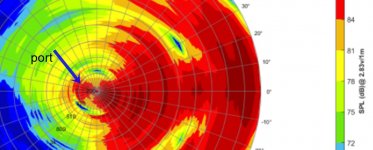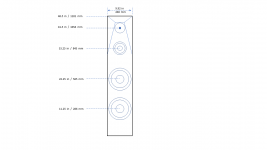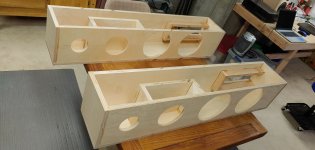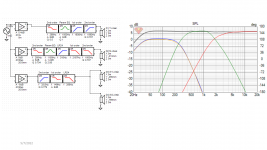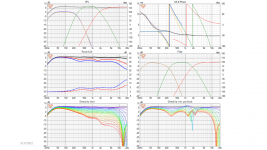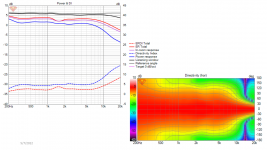Even more proof of the superiority of TMWW concept here
Emotiva Airmotiv T2+ Tower Speaker Review
Some may notice the low spl of low bass in CTA responses, but perhaps it is just an artefact because the port is very low and on the backside. Erin was ok with bass sound.
I would have chosen higher WT xo and a smaller mid... and sealed bass box if it was active with dsp!
Emotiva Airmotiv T2+ Tower Speaker Review
Some may notice the low spl of low bass in CTA responses, but perhaps it is just an artefact because the port is very low and on the backside. Erin was ok with bass sound.
I would have chosen higher WT xo and a smaller mid... and sealed bass box if it was active with dsp!
Attachments
Last edited:
I have really come to appreciate the burst decay plot (or "tone burst" or "time energy storage). Transforming the time axis from seconds to cycles makes the plot so much more useful.
I have used impedance sweeps to check for structural resonances, but I have not tried using that information to iteratively adjust the level of stuffing... I will this time
j.
I have used impedance sweeps to check for structural resonances, but I have not tried using that information to iteratively adjust the level of stuffing... I will this time
j.
---
I would have chosen higher WT xo and a smaller mid... and sealed bass box if it was active with dsp!
WM of course, edit time was over...
construction officially started
Today I rented a truck and bought the sheet stock for my cabinets. I can arrange the cut pattern such that each cabinet can be made from single 60" x 60" sheet of birch plywood. I bought three sheets so I have an extra one for a future project.
I also needed 4 sheets of conventional 4'x8' plywood for some built-in bookcases I am making, plus some cherry, maple, and oak lumber. Since I am renting a truck anyway it seemed a good idea to stock up.
Two years ago, I bought Baltic birch plywood for $55 per sheet. Now I paid $133 per sheet. It's almost enough to make me switch to MDF (but not quite). Even the domestic-produced oak-veneer plywood (red oak A2 face veneer, popular veneer core) has gotten expensive. I remember paying $100 for a 4x8 sheet a couple of years ago, and now I paid $177.
j.
Today I rented a truck and bought the sheet stock for my cabinets. I can arrange the cut pattern such that each cabinet can be made from single 60" x 60" sheet of birch plywood. I bought three sheets so I have an extra one for a future project.
I also needed 4 sheets of conventional 4'x8' plywood for some built-in bookcases I am making, plus some cherry, maple, and oak lumber. Since I am renting a truck anyway it seemed a good idea to stock up.
Two years ago, I bought Baltic birch plywood for $55 per sheet. Now I paid $133 per sheet. It's almost enough to make me switch to MDF (but not quite). Even the domestic-produced oak-veneer plywood (red oak A2 face veneer, popular veneer core) has gotten expensive. I remember paying $100 for a 4x8 sheet a couple of years ago, and now I paid $177.
j.
Today I rented a truck and bought the sheet stock for my cabinets. I can arrange the cut pattern such that each cabinet can be made from single 60" x 60" sheet of birch plywood. I bought three sheets so I have an extra one for a future project.
I also needed 4 sheets of conventional 4'x8' plywood for some built-in bookcases I am making, plus some cherry, maple, and oak lumber. Since I am renting a truck anyway it seemed a good idea to stock up.
Two years ago, I bought Baltic birch plywood for $55 per sheet. Now I paid $133 per sheet. It's almost enough to make me switch to MDF (but not quite). Even the domestic-produced oak-veneer plywood (red oak A2 face veneer, popular veneer core) has gotten expensive. I remember paying $100 for a 4x8 sheet a couple of years ago, and now I paid $177.
I know that all to well. I am a carpenter by trade and I am all to familiar with the exurbanite cost of lumber these days. It's terrible.
I've had two of my SB23MFCL45's in test box along with the Textream 6 1/2 and tweeter and have been playing around with them for a couple of weeks now and I think I found a winning combination. These drivers play really well together. The two 8" drivers are a great match with the Textream drivers in tonality and timber. Another thing I noticed was that the SB23MFCL45's are almost dead silent in their operation. There is no flutter, chuffing or mechanical noise coming from them at all. I only hear the program material. They are also very musical. I think they will work just fine.
As for box stuffing/dampening inside the box I use lead sheets and felt. Felt glued to the box and lead sheets attached over the felt with small brads to keep it in place. Works better then anything. It makes the box real heavy though and it can be a bit pricy. You can always stuff it with Dacron fill too but it really isn't needed except to maybe slow down the air velocity in the port. The lead does the job nicely. Works really well to isolate the midrange box too.
(16#) Sheet Lead 1/4" 1''' x 1''' - RotoMetals
https://www.amazon.com/Roto-Metals-...9fe84&pd_rd_wg=WnkZP&pd_rd_i=B001QV3G0I&psc=1
Even more proof of the superiority of TMWW concept here
Emotiva Airmotiv T2+ Tower Speaker Review
Some may notice the low spl of low bass in CTA responses, but perhaps it is just an artefact because the port is very low and on the backside. Erin was ok with bass sound.
I would have chosen higher WT xo and a smaller mid... and sealed bass box if it was active with dsp!
Yes I like the measurements of this speaker. A nice big ol' speaker. With good old fashioned belt and suspenders engineering, paying attention to 85% of the things that matter.
As Henry Ford once said, it's available in any colour that (s)he wants, so long as it is black.
And hopefully it sells by the truckloads, people will know what a real big speaker can sound like- it'll play loud and deep and clean. But sadly, I don't think it will. It looks really old fashioned.
If it was active and EQed, with DSP or ASP, it wouldn't need to be almost 12.5" wide.
I've got my own Johnny' come lately dual 12" 3-way coming (thanks for your advice via PM Juha!),
as well as a super slim triple 8" Purifi slim 3 way, if I can beg Lars to make a 16 ohm variant for me...
Last edited:
An even more proof for good ole times - basic rules - sealed 10" 4" 1"
SoundStage! Hi-Fi | SoundStageHiFi.com - KLH Model Five Loudspeakers 2000$/pair!
SoundStageNetwork.com | SoundStage.com - NRC Measurements: KLH Model Five Loudspeakers
"This is a case where old school and cutting edge have combined to create something that’s truly special—and at a very reasonable price. KLH finally seems to be on the right track with the Model Five—and I hope there’s more to come."


SoundStage! Hi-Fi | SoundStageHiFi.com - KLH Model Five Loudspeakers 2000$/pair!
SoundStageNetwork.com | SoundStage.com - NRC Measurements: KLH Model Five Loudspeakers
"This is a case where old school and cutting edge have combined to create something that’s truly special—and at a very reasonable price. KLH finally seems to be on the right track with the Model Five—and I hope there’s more to come."


I am changing my plans a bit. I now plan to make a separate woofer cabinet to house the two 8 inch woofers. I will also make a head unit to sit on top, containing the 5 inch driver and the tweeter. The overall dimensions will be the same as the original tower concept. This way I can swap out the head unit in the future if I wish.
I am also planning to have an amp-box mounted on the rear of the woofer cabinet, rather than recessing the electronics into the speaker. This simplifies the cabinet internal bracing. I plan to make the electronics box large enough so that if I do not like the sound of the Wondom amp I can switch to a Hypex amp without difficulty.
I am also planning to have an amp-box mounted on the rear of the woofer cabinet, rather than recessing the electronics into the speaker. This simplifies the cabinet internal bracing. I plan to make the electronics box large enough so that if I do not like the sound of the Wondom amp I can switch to a Hypex amp without difficulty.
I have all the electrical parts purchased, including connectors and power cords.... I have not powered anything up just yet. I have unpacked the Wondom amps and the power supplies, and they seem good quality...??? but who really knows until it is powered up and playing signals through a driver...
The JAB5 is really interesting, most of all its DSP function --I have all the electrical parts purchased, including connectors and power cords.... I have not powered anything up just yet. I have unpacked the Wondom amps and the power supplies, and they seem good quality...??? but who really knows until it is powered up and playing signals through a driver...
Looked at the guides for SigmaStudio in the product's download links section. I'd need to study them carefully & go slow! There must be a way to export settings from REW, VituixCAD or similar. Hopefully, the amp's basic parameters are good enough to make all that worthwhile -- distortion, power output, SNR...JAB5 is also integrated with high performance ADAU1701 DSP chip for audio signal processing. Four ports for external potentiometers are mounted on JAB5. You can use the external potentiometers to control the gain and frequency even if JAB5 is installed in a speaker. Please refer to the datasheet or connection guide for the detailed functions of potentiometers. After connection with WONDOM ICP5 or higher versions, you can write a program with SigmaStudio, or get real-time remote control of your audio systems via APP or PC UI, through which, you can adjust gain, volume, high/low-pass filter, EQ and other parameters. ICP5 is under test now and will be released in the near future.
Found some graphs on the performance tab of the JAB5 product page. Not exactly state of art... noise seems pretty high.
https://store.sure-electronics.com/images/product/1756/per-3.jpg
https://store.sure-electronics.com/images/product/1756/per-2.jpg
https://store.sure-electronics.com/images/product/1756/per-3.jpg
https://store.sure-electronics.com/images/product/1756/per-2.jpg
Yeah, I had seen similar plots for the Wondom 4 ch amp without DSP, I forget the name of it. That is why I am open minded about the performance and sound quality... could be fine, could be unacceptable. I am prepared to switch to a pair of Hypex FA123 or FA253 amps in that case.
I have a Dayton branded version of the Wondom, it is 100 watt mono amplifier with the same DSP which I piggy backed on a two channel 50 watt stereo amplifier. I used it for prototyping. I would say the power ratings are a bit exaggerated to say the least. I really like the Sigma studio, it is more powerful and versatile than a miniDSP or the QSC dsp i use. Unfortunately the USB programmer card is the weak link, from the start it was very difficult to get to work, it required hot plugging into the dsp board. A few weeks ago I pulled it out for a new project and I could not get it to connect at all (OK, once but after 10 or 12 tries and then I could get it to connect again) so I had to pull out the QSC and a SpeakerCraft 8 channel monster to get my work started. Maybe the Wondom won't have the same problem but there is no doubt that Wondom makes the Daytons because I used the Wondom documentation because there wasn't much Dayton documentation.Yeah, I had seen similar plots for the Wondom 4 ch amp without DSP, I forget the name of it. That is why I am open minded about the performance and sound quality... could be fine, could be unacceptable. I am prepared to switch to a pair of Hypex FA123 or FA253 amps in that case.
mtidge - Thanks for the heads-up. Although the JAB5 is rated for 100 W x 4, I am expecting closer to 75 W x 4 of usable clean power. We shall see. It may end up being a disappointment, although at the price I paid, no big deal...
Your comment about the USB programmer board got my attention. I bought two, one for each speaker, and I plan to leave it hooked up full time... again, we shall see if that works.
Your comment about the USB programmer board got my attention. I bought two, one for each speaker, and I plan to leave it hooked up full time... again, we shall see if that works.
It is on hold for now. I did some home remodeling over the winter, and it is taking longer than I expected. I will probably get back to it by June, perhaps ?
When I get back to this project, I will probably use a Hypex fusion amp instead of the Wondom JAB5. I think the Wondom will be used in a future portable outdoor speaker.
When I get back to this project, I will probably use a Hypex fusion amp instead of the Wondom JAB5. I think the Wondom will be used in a future portable outdoor speaker.
Construction has begun. I have cut all the panels except the outer baffle. I have glued the inner baffle, top/bottom, and one side. The next step is to install all the interior bracing, then second side wall, then finally the outer baffle.
This project has evolved since the start of the thread. The only parameter that remains the same is the driver selection. The cabinet dimensions have changed, the diffraction control strategy has changed, and I am no longer using the Wondom JAB5. A Hypex FA123 will be installed in base of each speaker.
I am now using tapered bevels, based on what I have learned in the course of this thread https://www.diyaudio.com/community/...tions-with-ideal-drivers.380658/#post-6880731 .
J.
This project has evolved since the start of the thread. The only parameter that remains the same is the driver selection. The cabinet dimensions have changed, the diffraction control strategy has changed, and I am no longer using the Wondom JAB5. A Hypex FA123 will be installed in base of each speaker.
I am now using tapered bevels, based on what I have learned in the course of this thread https://www.diyaudio.com/community/...tions-with-ideal-drivers.380658/#post-6880731 .
J.
Attachments
When I simulated this cabinet design using idealized drivers, the response looks pretty good. "Diffraction is destiny", and if the cabinet does not work with idealized drivers, it will probably not work with real drivers. I really appreciate the power of VituixCad because it allows me to construct a "final" cabinet without having to make several iterations of prototype cabinets. The actual filters I end up with after measuring and simulating my real drivers will no doubt be different from this idealized model, but that does not detract from the usefulness of this simulation. It gives me confidence that the concept is viable and feasible.
j.
j.
Attachments
Looks good Jim!
i did the same with my 3 way- simulated the cabinet dimensions and driver placement first; based on idealised drivers. As you know, Vituix’s models are based on flat piston drivers, not cones and domes.
After installing the my drivers and taking full spinorama measurements, I definitely had to adjust my theoretical crossover because although one can massage the drivers to be flat +/- 0.5dB with a dozen biquads, the off axis measurements of real drivers different from those based on the idealised drivers.
Initially I set my crossover point based ona combination of factors such as smooth off axis response and power response, as well as distortion (I aim for minimal non-linear distortion at 96dB/1m- because as you know, you can equalise for linear distortion but it easily for non-linear distortion)
But my crossover points had to change slightly.
My targets are idealised predicted in room response (+/-1 dB) of a gentle linear downsloping curve of 7.5dB from 20Hz to 20khz, whilst maintaining a listening window of +/- 2dB.
I also adjusted my crossover for a different design axis (modelled was for tweeter axis) but it turns out I could get better phase alignment between midrange and tweeter if I used the midrange as the design axis, without compromising on other (actually between listening window at 3m) as well as better predicted in-room response.
then after lots of listening and being relatively I then took full spinorama measurements again, and it was very close to the model. Just enough for of minor tweaks.
Finally listening in the intended room I add my preferred room curve (minor tweak to treble level with a shelf filter, or a resistor change)
Good luck!
i did the same with my 3 way- simulated the cabinet dimensions and driver placement first; based on idealised drivers. As you know, Vituix’s models are based on flat piston drivers, not cones and domes.
After installing the my drivers and taking full spinorama measurements, I definitely had to adjust my theoretical crossover because although one can massage the drivers to be flat +/- 0.5dB with a dozen biquads, the off axis measurements of real drivers different from those based on the idealised drivers.
Initially I set my crossover point based ona combination of factors such as smooth off axis response and power response, as well as distortion (I aim for minimal non-linear distortion at 96dB/1m- because as you know, you can equalise for linear distortion but it easily for non-linear distortion)
But my crossover points had to change slightly.
My targets are idealised predicted in room response (+/-1 dB) of a gentle linear downsloping curve of 7.5dB from 20Hz to 20khz, whilst maintaining a listening window of +/- 2dB.
I also adjusted my crossover for a different design axis (modelled was for tweeter axis) but it turns out I could get better phase alignment between midrange and tweeter if I used the midrange as the design axis, without compromising on other (actually between listening window at 3m) as well as better predicted in-room response.
then after lots of listening and being relatively I then took full spinorama measurements again, and it was very close to the model. Just enough for of minor tweaks.
Finally listening in the intended room I add my preferred room curve (minor tweak to treble level with a shelf filter, or a resistor change)
Good luck!
- Home
- Loudspeakers
- Multi-Way
- New Project - tower 3-way with twin 8s
